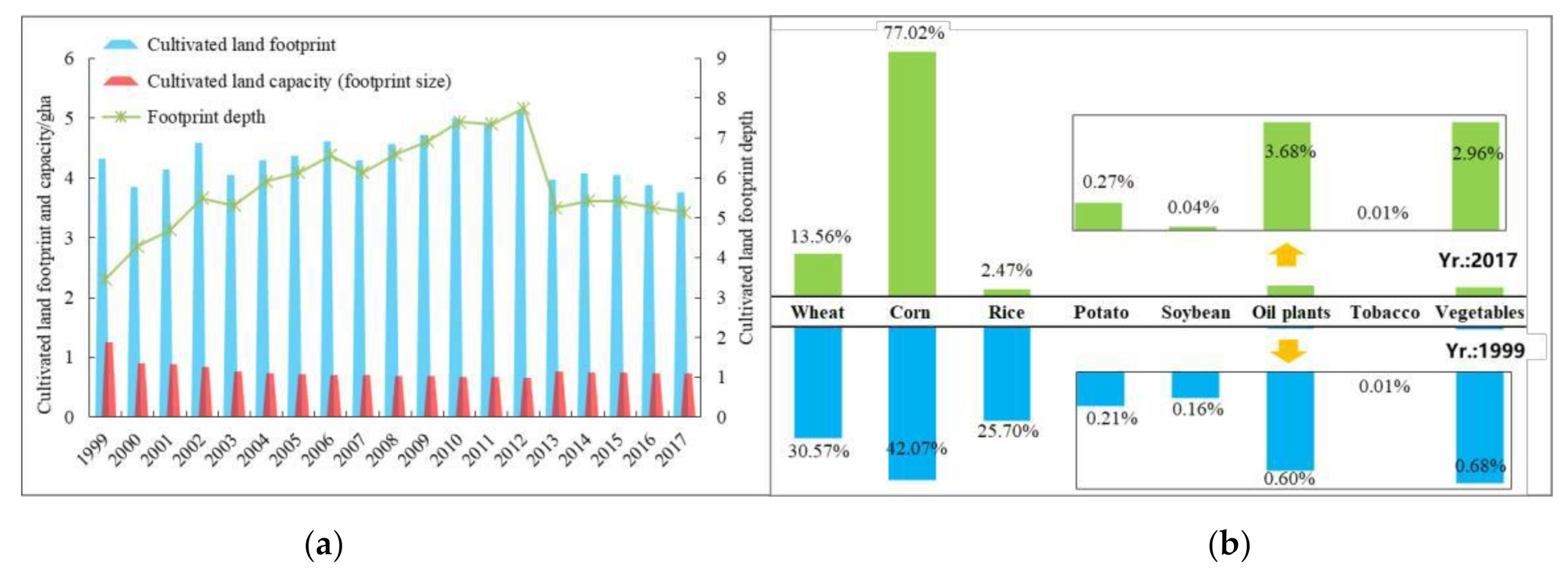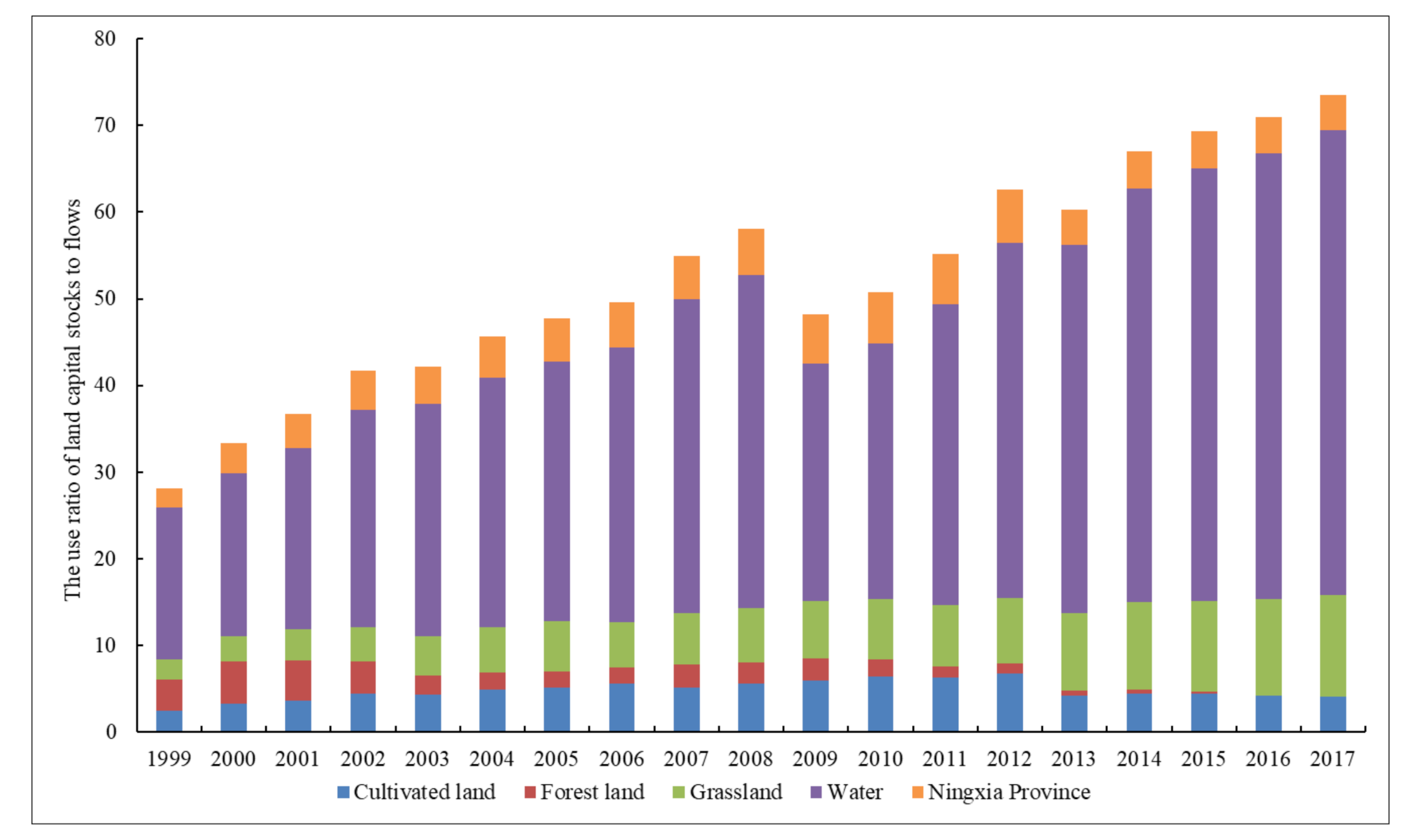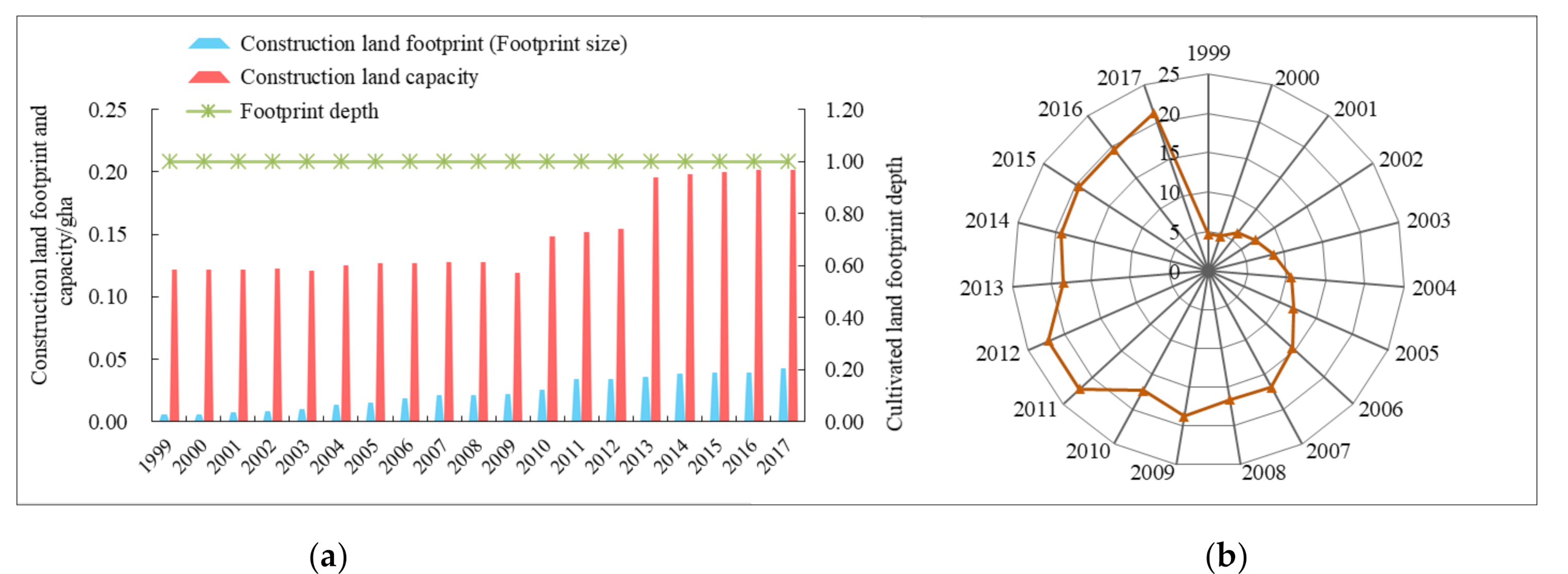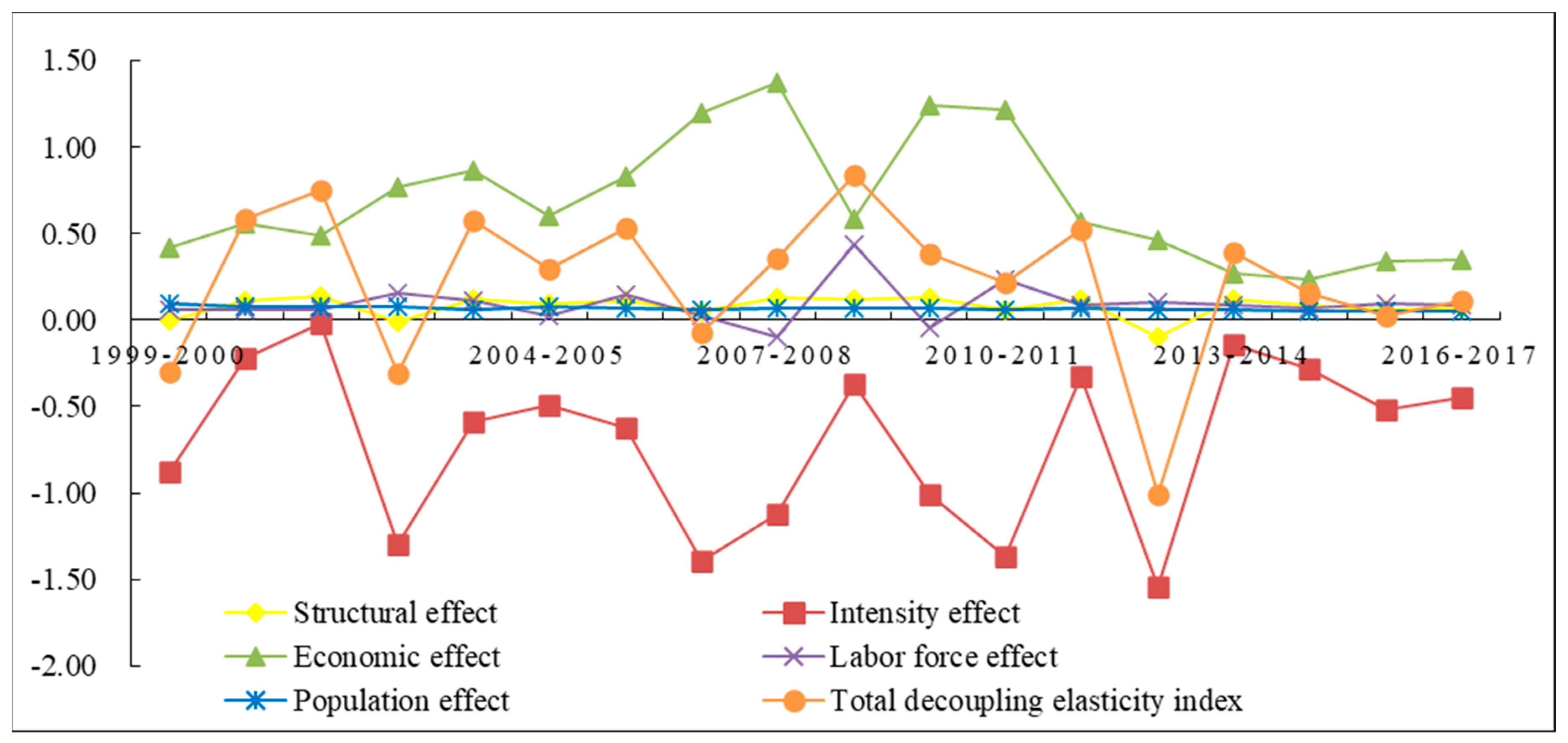Decoupling and Decomposition Analysis of Land Natural Capital Utilization and Economic Growth: A Case Study in Ningxia Hui Autonomous Region, China
Abstract
1. Introduction
2. Literature Review
3. Methods and Data Sources
3.1. Study Area and Data Resource
3.2. Improved Ecological Footprint Method
3.3. Decoupling Indicator
3.4. Decomposition Model
4. Results and Discussion
4.1. Analysis of the Land Natural Capital Utilization
4.1.1. Natural Capital Utilization of Cultivated Land
4.1.2. Natural Capital Utilization of Grassland
4.1.3. Natural Capital Utilization of Forest Land
4.1.4. Natural Capital Utilization of Water
4.1.5. Natural Capital Utilization of Construction Land
4.2. Analysis of the Decoupling Relationship
4.2.1. Decoupling State of Economic Growth and Land Capital Utilization
4.2.2. Decoupling State of Economic Growth and Each Bioproductive Land Type
4.3. Analysis of the Driving Factors on Decoupling Relationship
4.3.1. Structural Effect
4.3.2. Intensity Effect
4.3.3. Economic Effect
4.3.4. Effects of Labor Force and Population
5. Conclusions and Policy Implications
- (1)
- From the analysis of land natural capital utilization in Ningxia, it can be observed that the natural capital stock utilization of cultivated land decreased obviously, resulting in the declining trend of the in recent years. Similarly, in forest land, it decreased constantly and the flow occupation of natural capital could basically meet consumer demand since 2015. While, the of grassland and water increased rapidly and performed as the most unsustainable sectors among all land types. Moreover, the footprint of construction land occupied the smallest area of biological productive lands in Ningxia, but was the fastest-growing segment.
- (2)
- The decoupling analysis showed that the pressure of economic development on the sustainable use of land natural capital always exists. Overall, the decoupling state was preferred and dominated by strong decoupling and weak decoupling. The two stages appeared almost at the same frequency and only in 2001–2002 there was an expansive coupling. Specially, the cultivated land and forest land showed a preferred decoupling state in recent years, followed by grassland, while water and construction land showed the unfavorable expansive negative decoupling and weak decoupling.
- (3)
- In terms of the decomposition results, it can be obtained that economic effect is the biggest unfavorable factor limiting the strong decoupling, while intensity effect is the most favorable factor to promote the decoupling of land capital occupation from economic growth in Ningxia Province. Moreover, the impacts of structural effect, labor force effect and population effect on the decoupling are relatively weak.
- (1)
- In the central and southern mountains with fragile ecological environment (Guyuan city, South of Wuzhong City and Zhongwei city), considering the reality that grassland resource is abundant but overutilized seriously, measures related to the grassland and forest land protection, such as the Grain for Green Project, the Region-Wide Grazing Ban and the Three North Shelterbelt Forest Program, should be strictly implemented to improve ecological carrying capacity. Apart from that, due to the rapid expansion of urban construction land, later monitoring and management are crucial for the maintenance of ecological restoration achievements.
- (2)
- In the northern Yellow River irrigation area where is featured with higher economic development and better ecological environment (Yinchuan city and Shizuishan city), it is imperative to promote the transformation and upgrading of traditional industries and advance scientific and technological innovation for the purpose of reducing the impediment of economic effect on the decoupling relationship, and improving the intensity effect by improving the efficiency of resource utilization. At the same time, reasonably controlling the boundary of urban space expansion and optimizing the population structure to give full play to the powerful driving effect of talents on the economy instead of the overuse of natural resources.
- (3)
- Moreover, in the Ningxia Plain along the Yellow River, it is suggested to vigorously develop ecological, water-saving agriculture, reduce the use of fertilizer and control the loss of water resources, to alleviate the pressure of the extreme shortage of water resources.
Author Contributions
Funding
Institutional Review Board Statement
Informed Consent Statement
Data Availability Statement
Conflicts of Interest
References
- Kontokosta, C.E.; Jain, R.K. Modeling the determinants of large-scale building water use: Implications for data-driven urban sustainability policy. Sustain. Cities Soc. 2015, 18, 44–55. [Google Scholar] [CrossRef]
- Wang, Z.; Yang, L.; Yin, J.; Zhang, B. Assessment and prediction of environmental sustainability in China based on a modified ecological footprint model. Resour. Conserv. Recycl. 2018, 132, 301–313. [Google Scholar] [CrossRef]
- Blignaut, J.; Aronson, J. Getting serious about maintaining biodiversity. Conserv. Lett. 2008, 1, 12–17. [Google Scholar] [CrossRef]
- Benayas, J.M.R.; Newton, A.C.; Diaz, A.; Bullock, J.M. Enhancement of Biodiversity and Ecosystem Services by Ecological Restoration: A Meta-Analysis. Science 2009, 325, 1121–1124. [Google Scholar] [CrossRef]
- United Nations (UN). Transforming Our World: The 2030 Agenda for Sustainable Development. 2015. Available online: https://sustainabledevelopment.un.org/content/documents/21252030%20Agenda%20for%20Sustainable%20Development%20web.pdf (accessed on 5 December 2020).
- Fairbrass, A.; Mace, G.; Ekins, P.; Milligan, B. The natural capital indicator framework (NCIF) for improved national natural capital reporting. Ecosyst. Serv. 2020, 46, 101198. [Google Scholar] [CrossRef]
- Costanza, R.; Fioramonti, L.; Kubiszewski, I. The UN Sustainable Development Goals and the dynamics of well-being. Front. Ecol. Environ. 2016, 14, 59. [Google Scholar] [CrossRef]
- Fang, K.; Zhang, Q.; Yu, H.; Wang, Y.; Dong, L.; Shi, L. Sustainability of the use of natural capital in a city: Measuring the size and depth of urban ecological and water footprints. Sci. Total Environ. 2018, 631–632, 476–484. [Google Scholar] [CrossRef]
- Zhang, Z.; Hu, B.; Shi, K.; Su, K.; Yang, Q. Exploring the dynamic, forecast and decoupling effect of land natural capital utilization in the hinterland of the Three Gorges Reservoir area, China. Sci. Total Environ. 2019, 718, 134832. [Google Scholar] [CrossRef]
- Zhang, M.; Bai, C.; Zhou, M. Decomposition analysis for assessing the progress in decoupling relationship between coal consumption and economic growth in China. Resour. Conserv. Recycl. 2016, 129, 454–462. [Google Scholar] [CrossRef]
- Wang, Q.; Jiang, R.; Li, R. Decoupling analysis of economic growth from water use in City: A case study of Beijing, Shanghai, and Guangzhou of China. Sustain. Cities Soc. 2018, 41, 86–94. [Google Scholar] [CrossRef]
- Zhang, X.; Wang, Y.; Qi, Y.; Wu, J.; Liao, W.; Shui, W.; Zhang, Y.; Deng, S.; Peng, H.; Yu, X.; et al. Reprint of: Evaluating the trends of China’s ecological civilization construction using a novel indicator system. J. Clean. Prod. 2017, 163, S338–S351. [Google Scholar] [CrossRef]
- Guan, Y.; Kang, L.; Shao, C.; Wang, P.; Ju, M. Measuring county-level heterogeneity of CO2 emissions attributed to energy consumption: A case study in Ningxia Hui Autonomous Region, China. J. Clean. Prod. 2017, 142, 3471–3481. [Google Scholar] [CrossRef]
- Wackermagel, M.; Rees, W.E. Our Ecological Footprint, Reducing Human Impact on the Earth; New Society Publishers: Gabriela Island, PA, USA, 1996. [Google Scholar]
- Wackernagel, M.; Onisto, L.; Bello, P.; Callejas Linares, A.; Ina, S.L.F.; Mendez Garcia, J.; Ana, I.S.G.; Guadalupe Suarez Guerrero, M. National natural capital accounting with the ecological footprint concept. Ecol. Econ. 1999, 29, 375–390. [Google Scholar] [CrossRef]
- Li, J.; Chen, Y.; Xu, C.; Li, Z. Evaluation and analysis of ecological security in arid areas of Central Asia based on the emergy ecological footprint (EEF) model. J. Clean. Prod. 2019, 235, 664–677. [Google Scholar] [CrossRef]
- Rees, W.E. Ecological Footprints and appropriated carrying capacity: What urban economics leaves out. Environ. Urban. 1992, 4, 121–130. [Google Scholar] [CrossRef]
- Niccolucci, V.; Bastianoni, S.; Tiezzi, E.B.P.; Wackernagel, M.; Marchettini, N. How deep is the footprint? A 3D representation. Ecol. Model. 2009, 220, 2819–2823. [Google Scholar] [CrossRef]
- Niccolucci, V.; Galli, A.; Reed, A.; Neri, E.; Wackernagel, M.; Bastianoni, S. Towards a 3D National Ecological Footprint Geography. Ecol. Model. 2011, 222, 2939–2944. [Google Scholar] [CrossRef]
- Erb, K. Actual land demand of Austria 1926-2000: A variation on Ecological Footprint assessments. Land Use Policy 2004, 21, 247–259. [Google Scholar] [CrossRef]
- Miao, C.; Sun, L.; Yang, L. The studies of ecological environmental quality assessment in Anhui Province based on ecological footprint. Ecol. Indic. 2016, 60, 879–883. [Google Scholar] [CrossRef]
- Isman, M.; Archambault, M.; Racette, P.; Konga, C.N.; Llaque, R.M.; Lin, D.; Iha, K.; Ouellet-Plamondon, C.M. Ecological Footprint assessment for targeting climate change mitigation in cities: A case study of 15 Canadian cities according to census metropolitan areas. J. Clean. Prod. 2018, 174, 1032–1043. [Google Scholar] [CrossRef]
- Fan, Y.; Qiao, Q.; Xian, C.; Xiao, Y.; Fang, L. A modified ecological footprint method to evaluate environmental impacts of industrial parks. Resour. Conserv. Recycl. 2017, 125, 293–299. [Google Scholar] [CrossRef]
- Guo, S.; Wang, Y. Ecological Security Assessment Based on Ecological Footprint Approach in Hulunbeir Grassland, China. Int. J. Environ. Res. Public Health 2019, 16, 4805. [Google Scholar] [CrossRef]
- Li, X.; Tian, M.; Wang, H.; Wang, H.; Yu, J. Development of an ecological security evaluation method based on the ecological footprint and application to a typical steppe region in China. Ecol. Indic. 2014, 39, 153–159. [Google Scholar] [CrossRef]
- Xun, F.; Hu, Y. Evaluation of ecological sustainability based on a revised three-dimensional ecological footprint model in Shandong Province, China. Sci. Total Environ. 2019, 649, 582–591. [Google Scholar] [CrossRef]
- He, J.; Wan, Y.; Feng, L.; Ai, J.; Wang, Y. An integrated data envelopment analysis and emergy-based ecological footprint methodology in evaluating sustainable development, a case study of Jiangsu Province, China. Ecol. Indic. 2016, 70, 23–34. [Google Scholar] [CrossRef]
- Dong, H.; Li, P.; Feng, Z.; Yang, Y.; You, Z.; Li, Q. Natural capital utilization on an international tourism island based on a three-dimensional ecological footprint model: A case study of Hainan Province, China. Ecol. Indic. 2019, 104, 479–488. [Google Scholar] [CrossRef]
- Yang, Y.; Hu, D. Natural capital utilization based on a three-dimensional ecological footprint model: A case study in northern Shaanxi, China. Ecol. Indic. 2018, 87, 178–188. [Google Scholar] [CrossRef]
- Du, Y.; Peng, J.; Gao, Y.; Zhao, H. Sustainability evaluation of natural capital utilization based on a three-dimensional ecological footprint model: A case study of the Beijing-Tianjin-Hebei Metropolitan region. Prog. Geogr. 2016, 35, 1186–1196. [Google Scholar]
- Zhang, X.; Zeng, H. Dynamic of three-dimensional ecological footprint in the Pearl River Delta and its driving factors. Acta Sci. Circum. 2017, 37, 771–778. [Google Scholar]
- Cheng, Y.; Yin, J.; Wang, J. Research on natural capital evolution and influencing factors in the Yellow River Delta Region. China Popul. Resour. Environ. 2019, 29, 127–136. [Google Scholar]
- Yang, Y.; Ling, S.; Zhang, T.; Yao, C. Three-dimensional ecological footprint assessment for ecologically sensitive areas: A case study of the Southern Qin Ling piedmont in Shaanxi, China. J. Clean. Prod. 2018, 194, 540–553. [Google Scholar] [CrossRef]
- Peng, J.; Du, Y.; Ma, J.; Liu, Z.; Liu, Y.; Wei, H. Sustainability evaluation of natural capital utilization based on 3DEF model: A case study in Beijing City, China. Ecol. Indic. 2015, 58, 254–266. [Google Scholar] [CrossRef]
- Li, X.; Yang, Y.; Liu, Y. Research progress in man-land relationship evolution and its resource-environment in China. Acta Geogr. Sin. 2016, 71, 2067–2088. [Google Scholar] [CrossRef]
- Handavu, F.; Chirwa, P.W.C.; Syampungani, S. Socio-economic factors influencing land-use and land-cover changes in the miombo woodlands of the Copperbelt province in Zambia. Forest Policy Econ. 2019, 100, 75–94. [Google Scholar] [CrossRef]
- Skonhoft, A.; Solem, H. Economic growth and land-use changes: The declining amount of wilderness land in Norway. Ecol. Econ. 2001, 37, 289–301. [Google Scholar] [CrossRef]
- Yu, J.; Zhou, K.; Yang, S. Land use efficiency and influencing factors of urban agglomerations in China. Land Use Policy 2019, 88, 104143. [Google Scholar] [CrossRef]
- Ning, Y.; Zhang, B.; Ding, T.; Zhang, M. Analysis of regional decoupling relationship between energy-related CO2 emission and economic growth in China. Nat. Hazards 2017, 87, 867–883. [Google Scholar] [CrossRef]
- Organization for Economic Co-operation and Development (OECD). Sustainable Development: Indicators to measure De-coupling of Environmental Pressures from Economic Growth. 2002. Available online: http://www.oecd.org/officialdocuments/publicdisplaydocumentpdf/?cote=sg/sd(2002)1/final&doclanguage=en (accessed on 15 October 2002).
- Tapio, P. Towards a theory of decoupling: Degrees of decoupling in the EU and the case of road traffic in Finland between 1970 and 2001. Transp. Policy 2005, 12, 137–151. [Google Scholar] [CrossRef]
- Kovanda, J.; Hak, T. What are the possibilities for graphical presentation of decoupling? An example of economy-wide material flow indicators in the Czech Republic. Ecol. Indic. 2007, 7, 123–132. [Google Scholar] [CrossRef]
- Song, Y.; Sun, J.; Zhang, M.; Su, B. Using the Tapio-Z decoupling model to evaluate the decoupling status of China’s CO2 emissions at provincial level and its dynamic trend. Struct. Chang. Econ. Dyn. 2020, 52, 120–129. [Google Scholar] [CrossRef]
- Li, M.; Hao, J.; Chen, L.; Gu, T.; Chen, A. Decoupling of urban and rural construction land and population change in China at the prefectural level. Resour. Sci. 2019, 41, 1897–1910. [Google Scholar] [CrossRef]
- Mattila, T. Any sustainable decoupling in the Finnish economy? A comparison of the pathways and sensitivities of GDP and ecological footprint 2002–2005. Ecol. Indic. 2012, 16, 128–134. [Google Scholar] [CrossRef]
- Zhao, X.; Pan, Y.; Zhao, B.; He, R.; Liu, S.; Yang, X.; Li, H. Temporal-spatial evolution of the relationship between resource-environment and economic development in China: A method based on decoupling. Prog. Geogr. 2011, 30, 706–714. [Google Scholar]
- Wang, Q.; Zhao, M.; Li, R.; Su, M. Decomposition and decoupling analysis of carbon emissions from economic growth: A comparative study of China and the United States. J. Clean. Prod. 2018, 197, 178–184. [Google Scholar] [CrossRef]
- Song, W. Decoupling cultivated land loss by construction occupation from economic growth in Beijing. Habitat Int. 2014, 43, 198–205. [Google Scholar] [CrossRef]
- Wu, Y.; Tam, V.W.Y.; Shuai, C.; Shen, L.; Zhang, Y.; Liao, S. Decoupling China’s economic growth from carbon emissions: Empirical studies from 30 Chinese provinces (2001–2015). Sci. Total Environ. 2019, 656, 576–588. [Google Scholar] [CrossRef]
- Ang, B.W. Decomposition analysis for policymaking in energy: Which is the preferred method? Energy Policy 2004, 32, 1131–1139. [Google Scholar] [CrossRef]
- Ren, S.; Yin, H.; Chen, X.H. Using LMDI to analyze the decoupling of carbon dioxide emissions by China’s manufacturing industry. Environ. Dev. 2013, 9, 61–75. [Google Scholar] [CrossRef]
- Liu, S.; Ye, Y.; Lin, Y. Evolution characteristics and decomposition of driving factors on rural residential land based on decoupling theory and LMDI model. Trans. Chin. Soc. Agric. Eng. 2019, 35, 272–280. [Google Scholar]
- Cadavid Restrepo, A.M.; Yang, Y.R.; Hamm, N.A.S.; Gray, D.J.; Barnes, T.S.; Williams, G.M.; Soares, M.R.J.; McManus, D.P.; Guo, D.; Clements, A.C.A. Land cover change during a period of extensive landscape restoration in Ningxia Hui Autonomous Region, China. Sci. Total Environ. 2017, 598, 669–679. [Google Scholar] [CrossRef]
- Ningxia Statistics Bureau. Ningxia Statistical Yearbooks 2018; China Statistical Press: Beijing, China, 2018. [Google Scholar]
- Liu, M.; Zhang, D.; Min, Q.; Xie, G.; Su, N. The calculation of productivity factor for ecological footprints in China: A methodological note. Ecol. Indic. 2014, 38, 124–129. [Google Scholar] [CrossRef]
- Yang, L.; Yang, Y. Evaluation of eco-efficiency in China from 1978 to 2016: Based on a modified ecological footprint model. Sci. Total Environ. 2019, 662, 581–590. [Google Scholar] [CrossRef] [PubMed]
- Wackernagel, M.; Schulz, N.B.; Deumling, D.; Linares, A.C.; Jenkins, M.; Kapos, V.; Monfreda, C.; Loh, J.; Myers, N.; Norgaard, R. Tracking the ecological overshoot of the human economy. Proc. Natl Acad. Sci. USA 2002, 99, 9266–9271. [Google Scholar] [CrossRef] [PubMed]
- Xie, P.; Gao, S.; Sun, F. An analysis of the decoupling relationship between CO2 emission in power industry and GDP in China based on LMDI method. J. Clean. Prod. 2019, 211, 598–606. [Google Scholar] [CrossRef]
- Ma, M.; Cai, W. What drives the carbon mitigation in Chinese commercial building sector? Evidence from decomposing an extended Kaya identity. Sci. Total Environ. 2018, 634, 884–899. [Google Scholar] [CrossRef] [PubMed]
- Guo, S.; Wang, Y.; Hou, H.; Wu, C.; Yang, J.; He, W.; Xiang, L. Natural Capital Evolution and Driving Forces in Energy-Rich and Ecologically Fragile Regions: A Case Study of Ningxia Province, China. Sustainability 2020, 12, 562. [Google Scholar] [CrossRef]
- Jin, X.; Li, X.; Zhang, H.; Zhang, N.; Zhe, F. Dynamic evaluation of natural capital in Zhejiang Province based on the three-dimensional ecological footprint extension model. Chin. J. Ecol. 2019, 38, 2177–2183. [Google Scholar]







| Decoupling State | Decoupling Type | Meaning | ||||
|---|---|---|---|---|---|---|
| Decoupling | Strong decoupling (SD) | Ⅰ | Economic grows while land natural capital depletion decreases | |||
| Weak decoupling (WD) | Ⅱ | Economic grows while land natural capital depletion decreases slowly | ||||
| Recessive decoupling (RD) | Ⅲ | Economic grows slowly while land natural capital depletion decreases significantly | ||||
| Coupling | Expansive coupling (EC) | Ⅳ | Economic grows and land natural capital depletion increases moderately | |||
| Recessive coupling (RC) | Ⅴ | Economic declines and land natural capital depletion increases moderately | ||||
| Negative decoupling | Weak negative decoupling (WND) | Ⅵ | Economic declines and land natural capital depletion decreases slowly | |||
| Expansive negative decoupling (END) | Ⅶ | Economic grows and land natural capital depletion increases significantly | ||||
| Strong negative decoupling (SND) | Ⅷ | Economic declines while land natural capital depletion increases | ||||
| Year | Decoupling | Year | Decoupling | ||||||
| 1999–2000 | −0.088 | 0.102 | −0.860 | Ⅰ | 2008–2009 | 0.037 | 0.119 | 0.307 | Ⅱ |
| 2000–2001 | 0.076 | 0.101 | 0.755 | Ⅱ | 2009–2010 | 0.041 | 0.135 | 0.305 | Ⅱ |
| 2001–2002 | 0.098 | 0.102 | 0.959 | Ⅳ | 2010–2011 | −0.019 | 0.121 | −0.160 | Ⅰ |
| 2002–2003 | −0.095 | 0.127 | −0.750 | Ⅰ | 2011–2012 | 0.043 | 0.115 | 0.372 | Ⅱ |
| 2003–2004 | 0.060 | 0.112 | 0.532 | Ⅱ | 2012–2013 | −0.172 | 0.098 | −1.754 | Ⅰ |
| 2004–2005 | 0.023 | 0.109 | 0.211 | Ⅱ | 2013–2014 | 0.036 | 0.080 | 0.449 | Ⅱ |
| 2005–2006 | 0.038 | 0.127 | 0.299 | Ⅱ | 2014–2015 | −0.008 | 0.080 | −0.104 | Ⅰ |
| 2006–2007 | −0.033 | 0.127 | −0.263 | Ⅰ | 2015–2016 | −0.032 | 0.081 | −0.391 | Ⅰ |
| 2007–2008 | 0.051 | 0.126 | 0.403 | Ⅱ | 2016–2017 | −0.016 | 0.078 | −0.208 | Ⅰ |
| Year | Cultivated Land | Forest Land | Grassland | Water | Construction Land |
|---|---|---|---|---|---|
| 1999–2000 | −1.081 | −0.195 | 1.121 | 0.354 | −0.027 |
| 2000–2001 | 0.772 | −0.156 | 1.140 | 0.976 | 3.167 |
| 2001–2002 | 1.047 | −0.143 | 0.757 | 1.558 | 1.733 |
| 2002–2003 | −0.936 | −0.117 | 0.280 | 0.358 | 1.470 |
| 2003–2004 | 0.534 | −0.049 | 0.662 | 0.739 | 2.560 |
| 2004–2005 | 0.173 | 0.030 | 0.532 | 0.154 | 1.149 |
| 2005–2006 | 0.450 | −0.115 | −0.905 | 0.338 | 1.821 |
| 2006–2007 | −0.553 | 2.069 | 0.596 | 1.034 | 1.291 |
| 2007–2008 | 0.498 | −0.594 | 0.163 | 0.427 | −0.096 |
| 2008–2009 | 0.293 | 0.295 | 0.747 | 0.640 | 0.465 |
| 2009–2010 | 0.429 | −1.282 | 0.084 | 0.642 | 1.108 |
| 2010–2011 | −0.157 | −2.377 | −0.055 | 1.314 | 2.577 |
| 2011–2012 | 0.356 | −0.328 | 0.388 | 1.373 | 0.098 |
| 2012–2013 | −2.247 | −0.614 | 0.414 | 1.639 | 0.612 |
| 2013–2014 | 0.315 | −0.540 | 0.253 | 1.368 | 0.696 |
| 2014–2015 | −0.114 | −2.561 | 0.530 | 0.430 | 0.313 |
| 2015–2016 | −0.479 | −3.795 | 0.529 | 0.216 | −0.009 |
| 2016–2017 | −0.417 | −0.182 | 0.423 | 0.328 | 1.178 |
| Year | ||||||
|---|---|---|---|---|---|---|
| 1999–2000 | −0.001 | −0.873 | 0.422 | 0.055 | 0.095 | −0.301 |
| 2000–2001 | 0.117 | −0.220 | 0.556 | 0.059 | 0.075 | 0.587 |
| 2001–2002 | 0.139 | −0.015 | 0.493 | 0.062 | 0.075 | 0.753 |
| 2002–2003 | −0.008 | −1.299 | 0.767 | 0.159 | 0.076 | −0.305 |
| 2003–2004 | 0.118 | −0.585 | 0.863 | 0.112 | 0.064 | 0.572 |
| 2004–2005 | 0.094 | −0.496 | 0.602 | 0.026 | 0.074 | 0.300 |
| 2005–2006 | 0.109 | −0.622 | 0.832 | 0.148 | 0.066 | 0.534 |
| 2006–2007 | 0.049 | −1.393 | 1.194 | 0.024 | 0.057 | −0.070 |
| 2007–2008 | 0.130 | −1.119 | 1.375 | −0.097 | 0.065 | 0.353 |
| 2008–2009 | 0.124 | −0.366 | 0.584 | 0.434 | 0.067 | 0.843 |
| 2009–2010 | 0.127 | −1.005 | 1.238 | −0.044 | 0.071 | 0.387 |
| 2010–2011 | 0.062 | −1.364 | 1.218 | 0.239 | 0.060 | 0.213 |
| 2011–2012 | 0.121 | −0.322 | 0.566 | 0.084 | 0.071 | 0.520 |
| 2012–2013 | −0.097 | −1.541 | 0.465 | 0.106 | 0.059 | −1.007 |
| 2013–2014 | 0.118 | −0.140 | 0.274 | 0.083 | 0.056 | 0.391 |
| 2014–2015 | 0.085 | −0.280 | 0.236 | 0.070 | 0.048 | 0.159 |
| 2015–2016 | 0.057 | −0.515 | 0.339 | 0.094 | 0.052 | 0.027 |
| 2016–2017 | 0.072 | −0.451 | 0.351 | 0.086 | 0.049 | 0.108 |
Publisher’s Note: MDPI stays neutral with regard to jurisdictional claims in published maps and institutional affiliations. |
© 2021 by the authors. Licensee MDPI, Basel, Switzerland. This article is an open access article distributed under the terms and conditions of the Creative Commons Attribution (CC BY) license (http://creativecommons.org/licenses/by/4.0/).
Share and Cite
Guo, S.; Wang, Y.; Huang, J.; Dong, J.; Zhang, J. Decoupling and Decomposition Analysis of Land Natural Capital Utilization and Economic Growth: A Case Study in Ningxia Hui Autonomous Region, China. Int. J. Environ. Res. Public Health 2021, 18, 646. https://doi.org/10.3390/ijerph18020646
Guo S, Wang Y, Huang J, Dong J, Zhang J. Decoupling and Decomposition Analysis of Land Natural Capital Utilization and Economic Growth: A Case Study in Ningxia Hui Autonomous Region, China. International Journal of Environmental Research and Public Health. 2021; 18(2):646. https://doi.org/10.3390/ijerph18020646
Chicago/Turabian StyleGuo, Shanshan, Yinghong Wang, Jiu Huang, Jihong Dong, and Jian Zhang. 2021. "Decoupling and Decomposition Analysis of Land Natural Capital Utilization and Economic Growth: A Case Study in Ningxia Hui Autonomous Region, China" International Journal of Environmental Research and Public Health 18, no. 2: 646. https://doi.org/10.3390/ijerph18020646
APA StyleGuo, S., Wang, Y., Huang, J., Dong, J., & Zhang, J. (2021). Decoupling and Decomposition Analysis of Land Natural Capital Utilization and Economic Growth: A Case Study in Ningxia Hui Autonomous Region, China. International Journal of Environmental Research and Public Health, 18(2), 646. https://doi.org/10.3390/ijerph18020646




